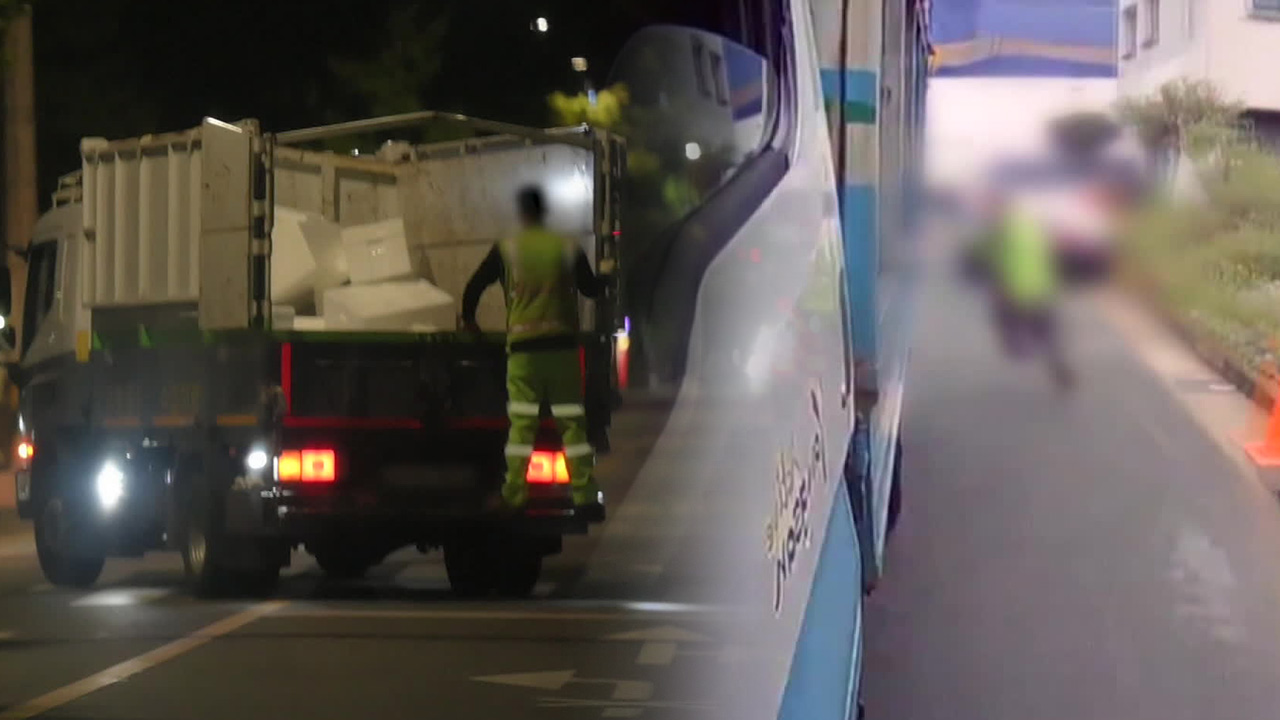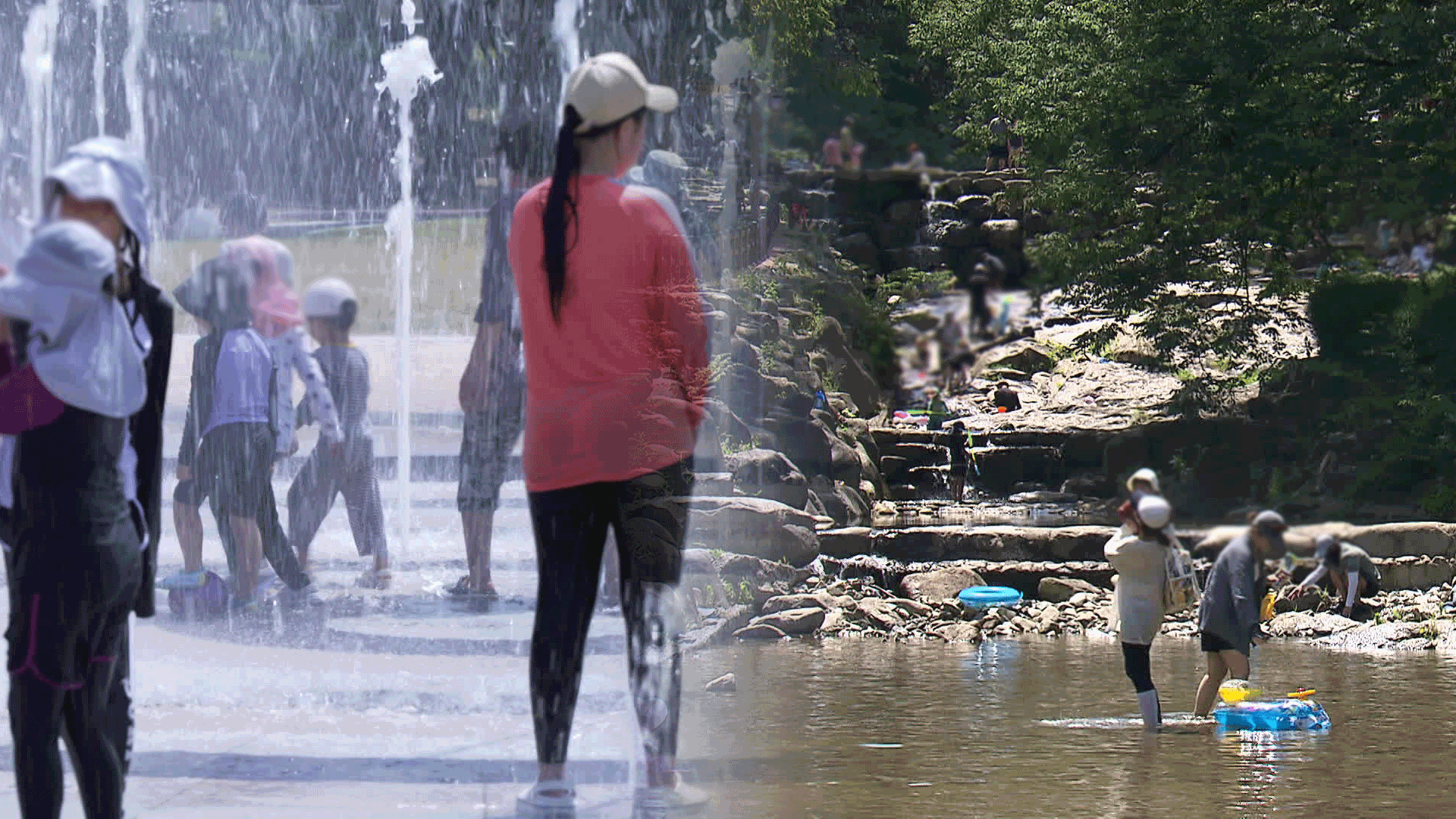Dangers of street cleaning work continue despite ban of footboard use and working late night hours
입력 2024.10.20 (23:38)
읽어주기 기능은 크롬기반의
브라우저에서만 사용하실 수 있습니다.
[Anchor]
Accidents involving street cleaning workers getting injured or dying while standing on the footboard of cleaning trucks are occurring one after another.
The government has prohibited the use of cleaning truck footboards and working at night since 2018 for safety reasons.
So why are such accidents still happening?
Reporter Kang Byeong-soo has the details.
[Report]
At a time past midnight, a cleaning truck heads out onto the street.
A street cleaning worker stands on the footboard of the cleaning truck, working through the early morning hours without a helmet.
["He is so unsafe..."]
In July, a 60-year-old street cleaning worker fell and died while standing on the footboard of a cleaning truck, and a year ago, another worker lost his left leg after being hit by a drunk driver while standing on the footboard.
Despite this, why do they continue to use the footboards?
I tried riding a cleaning truck without the footboard.
[Kang Byeong-soo/Reporter: "This is really high. It would be very difficult to work while going up and down like this."]
[Ham Yeong-ki/Street Cleaning Worker: "You can't get on and off frequently. Absolutely not."]
Instead of jumping on and off, moving on foot delays the cleaning time.
[Lee Seung-hwan/Street Cleaning Worker: "We have a lot of (trash) right now, so I don't think I can complete my route."]
[Lee Seung-hwan/Street Cleaning Worker: "We tried working without the footboard for about a month, but we received so many complaints at the time, and as soon as we put the footboard back on, all those complaints stopped."]
The government banned cleaning truck footboards in 2018 and introduced new Korean-style cleaning trucks that are easy and safe to get on and off.
However, the distribution rate is low, with only about 700 trucks nationwide.
In 2019, the Waste Management Act enforcement rules were revised to establish daytime work and a three-person team work principle.
However, local governments were allowed to make exceptions through ordinances.
[Local Government Official/Voice Altered: "First of all, there are a lot of complaints. It is quite a significant inconvenience for residents. During the day, the garbage collection vehicles tend to smell..."]
In the past six years, 38 street cleaning workers have died while working, and there are increasing calls for concrete practical measures.
This is KBS News, Kang Byeong-soo.
Accidents involving street cleaning workers getting injured or dying while standing on the footboard of cleaning trucks are occurring one after another.
The government has prohibited the use of cleaning truck footboards and working at night since 2018 for safety reasons.
So why are such accidents still happening?
Reporter Kang Byeong-soo has the details.
[Report]
At a time past midnight, a cleaning truck heads out onto the street.
A street cleaning worker stands on the footboard of the cleaning truck, working through the early morning hours without a helmet.
["He is so unsafe..."]
In July, a 60-year-old street cleaning worker fell and died while standing on the footboard of a cleaning truck, and a year ago, another worker lost his left leg after being hit by a drunk driver while standing on the footboard.
Despite this, why do they continue to use the footboards?
I tried riding a cleaning truck without the footboard.
[Kang Byeong-soo/Reporter: "This is really high. It would be very difficult to work while going up and down like this."]
[Ham Yeong-ki/Street Cleaning Worker: "You can't get on and off frequently. Absolutely not."]
Instead of jumping on and off, moving on foot delays the cleaning time.
[Lee Seung-hwan/Street Cleaning Worker: "We have a lot of (trash) right now, so I don't think I can complete my route."]
[Lee Seung-hwan/Street Cleaning Worker: "We tried working without the footboard for about a month, but we received so many complaints at the time, and as soon as we put the footboard back on, all those complaints stopped."]
The government banned cleaning truck footboards in 2018 and introduced new Korean-style cleaning trucks that are easy and safe to get on and off.
However, the distribution rate is low, with only about 700 trucks nationwide.
In 2019, the Waste Management Act enforcement rules were revised to establish daytime work and a three-person team work principle.
However, local governments were allowed to make exceptions through ordinances.
[Local Government Official/Voice Altered: "First of all, there are a lot of complaints. It is quite a significant inconvenience for residents. During the day, the garbage collection vehicles tend to smell..."]
In the past six years, 38 street cleaning workers have died while working, and there are increasing calls for concrete practical measures.
This is KBS News, Kang Byeong-soo.
■ 제보하기
▷ 카카오톡 : 'KBS제보' 검색, 채널 추가
▷ 전화 : 02-781-1234, 4444
▷ 이메일 : kbs1234@kbs.co.kr
▷ 유튜브, 네이버, 카카오에서도 KBS뉴스를 구독해주세요!
- Dangers of street cleaning work continue despite ban of footboard use and working late night hours
-
- 입력 2024-10-20 23:38:27

[Anchor]
Accidents involving street cleaning workers getting injured or dying while standing on the footboard of cleaning trucks are occurring one after another.
The government has prohibited the use of cleaning truck footboards and working at night since 2018 for safety reasons.
So why are such accidents still happening?
Reporter Kang Byeong-soo has the details.
[Report]
At a time past midnight, a cleaning truck heads out onto the street.
A street cleaning worker stands on the footboard of the cleaning truck, working through the early morning hours without a helmet.
["He is so unsafe..."]
In July, a 60-year-old street cleaning worker fell and died while standing on the footboard of a cleaning truck, and a year ago, another worker lost his left leg after being hit by a drunk driver while standing on the footboard.
Despite this, why do they continue to use the footboards?
I tried riding a cleaning truck without the footboard.
[Kang Byeong-soo/Reporter: "This is really high. It would be very difficult to work while going up and down like this."]
[Ham Yeong-ki/Street Cleaning Worker: "You can't get on and off frequently. Absolutely not."]
Instead of jumping on and off, moving on foot delays the cleaning time.
[Lee Seung-hwan/Street Cleaning Worker: "We have a lot of (trash) right now, so I don't think I can complete my route."]
[Lee Seung-hwan/Street Cleaning Worker: "We tried working without the footboard for about a month, but we received so many complaints at the time, and as soon as we put the footboard back on, all those complaints stopped."]
The government banned cleaning truck footboards in 2018 and introduced new Korean-style cleaning trucks that are easy and safe to get on and off.
However, the distribution rate is low, with only about 700 trucks nationwide.
In 2019, the Waste Management Act enforcement rules were revised to establish daytime work and a three-person team work principle.
However, local governments were allowed to make exceptions through ordinances.
[Local Government Official/Voice Altered: "First of all, there are a lot of complaints. It is quite a significant inconvenience for residents. During the day, the garbage collection vehicles tend to smell..."]
In the past six years, 38 street cleaning workers have died while working, and there are increasing calls for concrete practical measures.
This is KBS News, Kang Byeong-soo.
Accidents involving street cleaning workers getting injured or dying while standing on the footboard of cleaning trucks are occurring one after another.
The government has prohibited the use of cleaning truck footboards and working at night since 2018 for safety reasons.
So why are such accidents still happening?
Reporter Kang Byeong-soo has the details.
[Report]
At a time past midnight, a cleaning truck heads out onto the street.
A street cleaning worker stands on the footboard of the cleaning truck, working through the early morning hours without a helmet.
["He is so unsafe..."]
In July, a 60-year-old street cleaning worker fell and died while standing on the footboard of a cleaning truck, and a year ago, another worker lost his left leg after being hit by a drunk driver while standing on the footboard.
Despite this, why do they continue to use the footboards?
I tried riding a cleaning truck without the footboard.
[Kang Byeong-soo/Reporter: "This is really high. It would be very difficult to work while going up and down like this."]
[Ham Yeong-ki/Street Cleaning Worker: "You can't get on and off frequently. Absolutely not."]
Instead of jumping on and off, moving on foot delays the cleaning time.
[Lee Seung-hwan/Street Cleaning Worker: "We have a lot of (trash) right now, so I don't think I can complete my route."]
[Lee Seung-hwan/Street Cleaning Worker: "We tried working without the footboard for about a month, but we received so many complaints at the time, and as soon as we put the footboard back on, all those complaints stopped."]
The government banned cleaning truck footboards in 2018 and introduced new Korean-style cleaning trucks that are easy and safe to get on and off.
However, the distribution rate is low, with only about 700 trucks nationwide.
In 2019, the Waste Management Act enforcement rules were revised to establish daytime work and a three-person team work principle.
However, local governments were allowed to make exceptions through ordinances.
[Local Government Official/Voice Altered: "First of all, there are a lot of complaints. It is quite a significant inconvenience for residents. During the day, the garbage collection vehicles tend to smell..."]
In the past six years, 38 street cleaning workers have died while working, and there are increasing calls for concrete practical measures.
This is KBS News, Kang Byeong-soo.
-
-

강병수 기자 kbs0321@kbs.co.kr
강병수 기자의 기사 모음
-
이 기사가 좋으셨다면
-
좋아요
0
-
응원해요
0
-
후속 원해요
0















이 기사에 대한 의견을 남겨주세요.